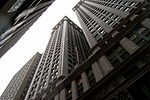Joie de Vivre
1998 establishments in New York City1998 sculpturesFinancial District, ManhattanNew York (state) sculpture stubsOutdoor sculptures in Manhattan ... and 1 more
Works by Mark di Suvero

Joie de Vivre (English: Joy of Life) is an outdoor sculpture by Mark di Suvero, located at Zuccotti Park in the Financial District of Lower Manhattan, New York City. The 70-foot sculpture, composed of "open-ended tetrahedrons", was installed by the intersection of Broadway and Cedar Street in June 2006 and was previously located at the Holland Tunnel rotary (also named St. John's Park).In October 2011, during Occupy Wall Street, a man climbed Joie de Vivre, where he remained for several hours until he was escorted down by police.
Excerpt from the Wikipedia article Joie de Vivre (License: CC BY-SA 3.0, Authors, Images).Joie de Vivre
Cedar Street, New York Manhattan
Geographical coordinates (GPS) Address External links Nearby Places Show on map
Geographical coordinates (GPS)
| Latitude | Longitude |
|---|---|
| N 40.70897 ° | E -74.01094 ° |
Address
Joie de Vivre
Cedar Street
10006 New York, Manhattan
New York, United States
Open on Google Maps








